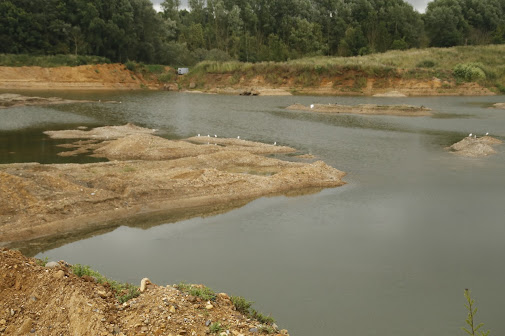The only GREAT CRESTED GREBES to have raised young in the area were here with a brood of three. WATER LILIES were growing in this intensively fished little lake, but not much else.
Riverside Farm Pit
This small lake - more like a large pond - was fairly busy. Standout bird was a WOOD DUCK, obviously an escapee as they originate from America, it was quite a strange sighting here, feeding on the grass that surrounds the lake. 30 CANADA GEESE provided the numbers and a pair of SWANS hadn't started nesting yet, if they intend to at all.
A GREY WAGTAIL was present around the lock in the river here, they usually nest in this area so hopefully they will do so again this year.
Pippin's Lake
Another, small lake, with wooded surrounds, Pippin's held good numbers of GADWALL, with two broods of three and four, plus twelve more adults, which were good numbers for the area at this time of year. It seems that around Pipps Ford gadwall are the most common breeding duck, more so than mallards. Also present were a SWAN brood of six, this is a regular nesting site for this bird, I disturbed them, by accident, the adults hissing at me as they swam away.
The Exhausted Quarry
For some reason this area is completely submerged under water, forming a little lake, when usually there is some wet grassland in the mix. This increase in water has benefitted the local COOT population with three pairs nesting here. Two of the pairs were on second broods, of five and two, with the other pair still on their first, of two. In case you're wondering about coots, they're doing well, no need to worry at all with them. The young birds have little red heads, which confused me when I younger. I used to think they were moorhens who were hanging out with the coot. A pair of LITTLE GREBE were about, but haven't nested yet, if they're going to bother at all.
The surrounding rough grassland was coloured white in parts with stands of OXEYE DAISY, and blue with VIPER'S BUGLOSS. SKYLARKS flew around the grasslands carrying food to the nest, this area is really good for this declining bird.
The Active Quarry
This place is always changing as the diggers work on the land. Lorries come and go, creating lots of disturbance, and I wonder why birds bother with all this, but bother they do, and you can see plenty of birds around all this human activity. The active quarry is a large area of water with islands and some mud, which proves attractive to birds.
Another GADWALL brood, this time with three ducklings. There were small numbers of other wildfowl, with two pairs of TUFTED DUCK, a pair of LITTLE GREBE, and nesting GREAT CRESTED GREBE.
A couple of WADERS were about, which could be birds still nesting or wandering autumn migrants. One LITTLE RINGED PLOVER, four LAPWING and an OYSTERCATCHER were here.
Unfortunately the SAND MARTIN colony has disappeared this year. They usually nest in the sand cliffs of the active quarry, but this year they have deserted the area. This has also happened to another colony, Minsmere, where birds have decided not to nest there either. This could be alarming, a crash of colonies, or it could just be the capriciousness of birds, and they are nesting elsewhere, its hard to tell.
A quiet time of year, compared with any other, but it still throws up some interesting sightings. Even the most unpromising of places can throw up the odd goodie, allowing you to doubly savour it if its on a local patch. These places are your places, the ones where only you bird watch, ones that you know like the back of your hand, where you will sniff out any rarity. They make bird watching that extra bit juicy, adding another dimension to this glorious hobby.






No comments:
Post a Comment